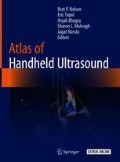Abstract
Pericardial effusion is a relatively common finding in high-risk patients evaluated in the emergency department [1]. It should be considered in differential diagnosis for patients with different clinical presentations such as shortness of breath, chest pain, and hypotension [2]. Physical examination alone may not be very accurate in identifying patients with cardiac tamponade and point-of-care ultrasound has been shown to be a very useful clinical tool [3]. Pericardial effusion is easily identified by ultrasound examination. Hemodynamic significance of the effusion can be assessed by a set of additional findings such as chamber collapse, flow variation across the atrioventricular valves, and inferior vena cava engorgement. These require good understanding of tamponade physiology, training in spectral Doppler and M-mode echocardiography, and advanced examination skills.
Access this chapter
Tax calculation will be finalised at checkout
Purchases are for personal use only
References
Mandavia DP, Hoffner RJ, Mahaney K, Henderson SO. Bedside echocardiography by emergency physicians. Ann Emerg Med. 2001;38(4):377–82.
Arntfield RT, Millington SJ. Point of care cardiac ultrasound applications in the emergency department and intensive care unit--a review. Curr Cardiol Rev. 2012;8(2):98–108.
Argulian E, Messerli F. Misconceptions and facts about pericardial effusion and tamponade. Am J Med. 2013;126(10):858–61.
Argulian E, Herzog E, Halpern DG, Messerli FH. Paradoxical hypertension with cardiac tamponade. Am J Cardiol. 2012;110(7):1066–9.
Acknowledgments
All images courtesy of Dr. Edgar Argulian.
Author information
Authors and Affiliations
Corresponding author
Editor information
Editors and Affiliations
18.1 Electronic Supplementary Material
331350_1_En_18_MOESM1_ESM.mp4
Pericardial effusion in the parasternal long axis view. In this view, the left atrium (LA), left ventricle (LV), right ventricular outflow tract (RVOT) and aortic valve (AV) are seen. Left ventricular ejection fraction is reduced. Pericardial effusion (Pef) appears as an echo free space around the heart, both anteriorly and posteriorly. Descending aorta (DA) allows differentiation of pericardial effusion from left pleural effusion: it is seen behind the echo bright pericardium. See also Fig. 18.1 (AVI 2272 kb)
Pericardial effusion in the subcostal view. In this view, the right ventricle (RV) and right atrium (RA) are closer to the transducer, while the left ventricle (LV) and left atrium (LA) are in the far field. Pericardial effusion (Pef) appears as an echo free space around the heart, both along the diaphragm above the liver (Lr) and along the lateral wall of the left ventricle. See also Fig. 18.2 (AVI 9574 kb)
331350_1_En_18_MOESM3_ESM.mp4
Pericardial effusion and pleural effusion in the parasternal long axis view. Pericardial effusion can occasionally be confused with left pleural effusion, right pleural effusion, ascites, and pericardial fat. In this patient, a large pericardial effusion (Pef) is seen as an echo free space behind the inferolateral wall of the left ventricle. Left pleural effusion (Pl) is also seen. Note the position of the descending aorta (Da) behind the bright line of the pericardium. See also Fig. 18.3 (AVI 1883 kb)
Ascites and right pleural effusion in the subcostal view. This patient with biventricular dysfunction has anasarca. Ascites (Asc) is seen as an echo free space below the diaphragm; one can also identify the falciform ligament (FL). Right pleural effusion (Pl) is seen as an echo free space above the diaphragm. The highly echogenic implantable defibrillator lead is seen in the right ventricle. See also Fig. 18.4 (AVI 17972 kb)
Pericardial fat in the parasternal long axis view. Pericardial fat commonly appears as hypoechoic area overlying the right ventricular outflow tract (RVOT) in the parasternal long axis view. It should not be confused with pericardial effusion. The thin and bright line of the parietal pericardium is seen (arrow) separating the anterior pericardial fat from posterior epicardial fat. See also Fig. 18.5 (AVI 13883 kb)
331350_1_En_18_MOESM6_ESM.mp4
Pericardial effusion with right atrial collapse. Pericardial effusion (Pef) is seen as echo free space around the right atrium and right ventricle. Right atrial collapse (arrow) is seen as the intrapericardial pressure transiently exceeds the right atrial pressure. Short-lived right atrial collapse is a non-specific finding. Sustained right atrial collapse lasting more than one-third of the cardiac cycle is more specific for cardiac tamponade. See also Fig. 18.6 (AVI 10232 kb)
Video 18.1
Pericardial effusion in the parasternal long axis view. In this view, the left atrium (LA), left ventricle (LV), right ventricular outflow tract (RVOT) and aortic valve (AV) are seen. Left ventricular ejection fraction is reduced. Pericardial effusion (Pef) appears as an echo free space around the heart, both anteriorly and posteriorly. Descending aorta (DA) allows differentiation of pericardial effusion from left pleural effusion: it is seen behind the echo bright pericardium. See also Fig. 18.1 (AVI 2272 kb)
Video 18.3
Pericardial effusion and pleural effusion in the parasternal long axis view. Pericardial effusion can occasionally be confused with left pleural effusion, right pleural effusion, ascites, and pericardial fat. In this patient, a large pericardial effusion (Pef) is seen as an echo free space behind the inferolateral wall of the left ventricle. Left pleural effusion (Pl) is also seen. Note the position of the descending aorta (Da) behind the bright line of the pericardium. See also Fig. 18.3 (AVI 1883 kb)
Video 18.6
Pericardial effusion with right atrial collapse. Pericardial effusion (Pef) is seen as echo free space around the right atrium and right ventricle. Right atrial collapse (arrow) is seen as the intrapericardial pressure transiently exceeds the right atrial pressure. Short-lived right atrial collapse is a non-specific finding. Sustained right atrial collapse lasting more than one-third of the cardiac cycle is more specific for cardiac tamponade. See also Fig. 18.6 (AVI 10232 kb)
Rights and permissions
Copyright information
© 2018 Springer International Publishing AG, part of Springer Nature
About this chapter
Cite this chapter
Argulian, E., Narula, J. (2018). Pericardial Effusion and Tamponade. In: Nelson, B., Topol, E., Bhagra, A., Mulvagh, S., Narula, J. (eds) Atlas of Handheld Ultrasound. Springer, Cham. https://doi.org/10.1007/978-3-319-73855-0_18
Download citation
DOI: https://doi.org/10.1007/978-3-319-73855-0_18
Published:
Publisher Name: Springer, Cham
Print ISBN: 978-3-319-73853-6
Online ISBN: 978-3-319-73855-0
eBook Packages: MedicineMedicine (R0)

